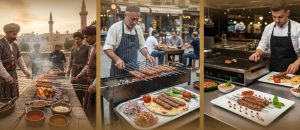Long before modern ovens and intricate cookware, humanity discovered a profound culinary secret: the clay pot. This humble vessel, born from the very earth, revolutionized cooking by trapping moisture, concentrating flavors, and tenderizing even the toughest ingredients through slow, even heat. The enduring legacy of clay pot cooking, a practice spanning millennia and continents, finds some of its deepest roots and most iconic expressions in Anatolia, culminating in dishes like Testi Kebabı. This in-depth article, a vital Cluster Content piece supporting our “Testi Kebabı: Anatolia’s Clay Pot Culinary Secret and Dance with Fire” Pillar Page, will embark on a sweeping historical and global journey. For food historians and culinary tourists alike, we will trace the origins of earthenware cooking from Neolithic settlements to ancient empires, explore its diffusion across the Silk Road, and finally focus on its remarkable evolution and continued significance in Anatolian cuisine. Join us as we uncover how the ancient art of clay pot cooking represents a timeless connection to our shared culinary past.
Earth’s Embrace: Unearthing the Ancient Art of Clay Pot Cooking
Clay pot cooking is one of humanity’s oldest and most enduring culinary arts, fundamentally shaping how food was prepared and consumed across diverse cultures for millennia. Its ingenious simplicity provided a transformative method for cooking, particularly for tough meats and hardy vegetables.
From Necessity to Art: Why Clay Pots Endured
Clay pots endured for thousands of years as a primary cooking vessel due to their inherent practicality, efficiency, and ability to enhance flavor and texture.
- Abundant Material: Clay was a ubiquitous and easily accessible natural resource in many parts of the world, especially in regions with rich riverbeds. Its workability allowed for the creation of various vessel shapes and sizes.
- Heat Retention and Distribution: Clay is an excellent insulator. When heated, clay pots retain heat for long periods and distribute it very evenly, preventing hot spots and allowing for gentle, thorough cooking. This was crucial in early ovens or pit fires where heat sources could be inconsistent.
- Moisture Management: The porous nature of unglazed clay (when properly soaked) allows it to absorb and then slowly release moisture, creating a self-steaming environment within the pot. This traps juices, tenderizes tough cuts of meat, and prevents food from drying out.
- Flavor Concentration: The sealed or semi-sealed environment of a clay pot cooking minimizes the escape of volatile aromatic compounds. This concentrates flavors, allowing ingredients to meld deeply and create rich, complex tastes.
- Versatility: Clay pots could be used for various cooking methods: baking, stewing, roasting, and even direct fire cooking (for specific types). This versatility made them indispensable in ancient kitchens.
Our Global Culinary Journey: Tracing Clay’s Footprint
This article will embark on a global culinary journey, tracing the remarkable footprint of clay pot cooking across different civilizations and continents, highlighting its enduring legacy.
- Neolithic Innovations: We will start with the earliest evidence of pottery use for cooking during the agricultural revolution.
- Ancient Empires: Explore its role in the sophisticated cuisines of Mesopotamia, Egypt, Greece, and Rome.
- Global Diffusion: Follow its spread and adaptation along ancient trade routes like the Silk Road, influencing cultures in North Africa, the Middle East, Asia, and even Latin America.
- Anatolian Significance: Focus on Anatolia’s unique contribution to clay pot cooking, culminating in iconic dishes like Testi Kebabı.
- Scientific Principles: Uncover the scientific reasons behind clay’s effectiveness in slow cooking.
Neolithic Dawn: The Birth of Pottery and Domestic Cooking
The advent of pottery during the Neolithic Revolution marked a transformative epoch in human culinary history, moving beyond direct fire cooking to more controlled and efficient domestic food preparation. This innovation was deeply intertwined with the rise of agriculture and settled lifestyles.
The Agricultural Revolution and the Rise of Cooking Vessels
The shift from hunting and gathering to agriculture, beginning around 10,000 BCE, fundamentally reshaped human diets and created a demand for new cooking technologies.
- Settled Lifestyles: Agriculture allowed for permanent settlements, replacing nomadic movements. This stability enabled the creation and use of heavier, more fragile cooking implements like pottery.
- New Food Sources: Cultivated grains (wheat, barley, rice) and legumes (lentils, beans) required different cooking methods than meat alone. Boiling and simmering in vessels became crucial for making these foods palatable and digestible.
- Food Storage: Pottery was not only for cooking but also for long-term storage of harvested crops and preserved foods, essential for settled communities.
- Beyond Direct Fire: Pottery allowed for indirect cooking (boiling, steaming, stewing) away from direct flame, providing greater control over temperature and cooking duration. This led to a wider variety of cooking techniques and dishes.
- Nutritional Enhancement: Boiling grains and legumes in water in clay pots made their nutrients more accessible and increased their safety, contributing to the health and growth of early agricultural populations.
Early Anatolian Pottery: Çatalhöyük and Beyond
Anatolia, a cradle of civilization and a key region for the Neolithic Revolution, boasts some of the earliest and most sophisticated examples of pottery used for domestic cooking.
- Çatalhöyük (7500-5700 BCE): This prominent Neolithic site in south-central Anatolia provides extensive archaeological evidence of advanced pottery production. Residents of Çatalhöyük used ceramic vessels for cooking, storage, and possibly even ritualistic purposes.
- Domestic Use: Excavations reveal various sizes and shapes of pottery, including cooking pots designed to withstand heat, indicating their central role in daily domestic life and food preparation.
- Hacılar and Other Sites: Other Anatolian Neolithic sites like Hacılar (circa 7000 BCE) also show highly developed pottery cultures, producing aesthetically pleasing and functional vessels.
- Technological Advancement: Early Anatolian potters demonstrated remarkable skill in clay preparation, shaping, and firing techniques. Their understanding of clay’s properties allowed them to create durable vessels capable of withstanding the rigors of cooking over open fires or in simple ovens.
- Culinary Impact: The widespread availability and use of pottery in Anatolia during this period fundamentally transformed the local diet, enabling the creation of stews, porridges, and slow-cooked dishes that were previously impossible, laying a deep historical foundation for future clay pot cooking traditions, including Testi Kebabı. This region’s continuous pottery tradition underscores its lasting impact on culinary practices.
Ancient Empires: Clay Pots in Mesopotamia, Egypt, and the Mediterranean
As organized civilizations and empires rose in the ancient world, the use of clay pots for cooking and storage became increasingly sophisticated and integral to their diverse culinary systems. From the fertile crescents of Mesopotamia to the Nile’s bounty in Egypt and the bustling trade routes of the Mediterranean, earthenware vessels played a crucial role in shaping ancient diets and culinary practices.
Mesopotamian and Egyptian Culinary Vessels
The rich agricultural lands of Mesopotamia and the life-giving Nile of Egypt fostered complex societies where clay pots were essential for daily sustenance and grand feasts.
- Mesopotamia (circa 3500-539 BCE):
- Versatile Pottery: Sumerians, Akkadians, Babylonians, and Assyrians utilized a wide range of pottery for cooking, brewing beer, and storing grains and oils. Early forms of stewing and baking in clay vessels were common.
- Tannur Ovens: The “tannur” (or tandoor) oven, a clay oven often found in archaeological sites, was a common cooking technology. Clay pots were used within these ovens for baking bread and slow-cooking meat and vegetable stews, much like modern Testi Kebabı principles.
- Culinary Records: Cuneiform tablets contain recipes that hint at complex dishes prepared in vessels, suggesting a sophisticated use of clay pots for flavor development.
- Ancient Egypt (circa 3100-30 BCE):
- Bread and Beer: Egyptian civilization relied heavily on bread and beer, both prepared with the aid of clay vessels for mixing, fermenting, and baking.
- Stewing and Roasting: Pottery was used for stewing meats, vegetables, and legumes. Large clay pots were also employed for roasting, sometimes containing whole birds or cuts of meat sealed inside with mud, creating an early form of contained cooking.
- Funerary Offerings: Clay pots filled with food were often found in tombs as offerings for the afterlife, demonstrating their intrinsic value and their role in providing sustenance. This underscores the deep cultural importance of clay pot cooking.
Greek Pithoi and Roman Dolia: Large-Scale Clay Storage and Cooking
Classical Greek and Roman civilizations, known for their agricultural output and extensive trade, utilized massive clay vessels not only for cooking but also for large-scale storage, showcasing their ingenuity in pottery technology.
- Greek Pithoi:
- Description: “Pithoi” were enormous, often human-sized, earthenware storage jars used by the ancient Greeks. While primarily for storing olive oil, wine, grains, and dried foods, some smaller versions or fragments suggest they might have also been used for large-scale cooking or fermentation.
- Cooking Implications: The principle of storing food in an airtight or semi-airtight clay vessel, which naturally regulated temperature and moisture, influenced cooking practices. Foods stored in pithoi could also undergo slow fermentation, developing complex flavors.
- Roman Dolia:
- Description: Similar to Greek pithoi, “dolia” were large, thick-walled earthenware vats used by the Romans for storing wine, olive oil, and fermenting grapes. They were often buried halfway into the ground for temperature regulation.
- Culinary Use: While mainly storage, the dolia’s properties (insulation, consistent temperature) mirrored those ideal for slow cooking. Historical accounts suggest that some form of slow-braising or fermenting food in smaller clay vessels, utilizing principles found in these large storage containers, was also practiced.
- Amphorae: Smaller clay amphorae were used for transporting and storing various foodstuffs, indicating the widespread use of clay vessels in Roman culinary logistics. The use of contained clay vessels was a cornerstone of ancient Mediterranean food systems, laying a conceptual groundwork for specialized cooking pots.
The Silk Road and Beyond: Global Diffusion of Earthenware Cooking
The ancient network of trade routes known as the Silk Road played a crucial role in the global diffusion of culinary techniques, including clay pot cooking, influencing diverse cultures across continents. This exchange of goods, ideas, and cooking methods led to the independent development of various iconic earthenware dishes worldwide.
North Africa and the Middle East: Tagines and Tannours
In North Africa and the Middle East, clay pot cooking evolved into distinctive forms, often reflecting local ingredients and cooking traditions.
- Tagine (North Africa – Morocco, Algeria, Tunisia):
- Description: The “tagine” is a unique two-piece clay cooking pot, with a shallow circular base and a tall, conical lid.
- Cooking Method: It is designed for slow-cooking stews (also called tagines) on a stovetop or in an oven. The conical lid traps steam and returns condensed moisture to the food, ensuring incredibly tender meat and vegetables, and concentrating flavors.
- Similarity to Testi Kebabı: Shares the principle of contained, moist-heat cooking, tenderizing ingredients through a self-basting steam environment.
- Tannour/Tandoor (Middle East, Central Asia, South Asia):
- Description: A bell-shaped or cylindrical clay oven, often partially buried in the ground.
- Cooking Method: While famous for baking flatbreads (naan, lavaş) by sticking them to the hot walls, tandoors are also used for roasting meats (tandoori chicken, various kebabs) and slow-cooking stews in clay pots, utilizing the intense radiant heat from the walls.
- Connection to Testi: Many versions of pit-cooked kebabs or clay pot stews across the region share the technological ancestry of the tandoor, providing a direct link to Testi Kebabı’s traditional cooking environment.
Asian and Latin American Clay Traditions: From Claypots to Cazuelas
The global reach of clay pot cooking extends far beyond the Mediterranean and Middle East, with vibrant traditions found in Asia and Latin America.
- Asian Claypot Cooking (China, Vietnam, Philippines):
- Description: Various lidded clay pots are used for slow-cooking stews, rice dishes, and braises.
- Cooking Method: They are often used on stovetops or in ovens, allowing for long, gentle cooking that develops rich, complex flavors and tender textures, very similar to the benefits of Testi Kebabı. Dishes like “claypot rice” are iconic.
- Latin American Cazuelas (Mexico, Peru, Chile):
- Description: “Cazuelas” are traditional earthenware cooking pots, often shallow and wide, used for stews, soups, and roasting.
- Cooking Method: Used over open fires, on stovetops, or in ovens, cazuelas retain heat exceptionally well, facilitating slow, even cooking and deep flavor development in dishes like stews and traditional beans.
- Universal Principles: These global examples underscore the universal scientific principles that make clay pots effective: excellent heat retention, even heat distribution, and moisture control (especially in lidded vessels). Regardless of the specific dish or culture, clay pots are celebrated for their ability to transform ingredients through gentle, extended cooking, proving their timeless appeal across diverse culinary landscapes.
Anatolia’s Enduring Legacy: The Evolution to Testi Kebabı
Anatolia, with its millennia-old pottery traditions and rich culinary history, has cultivated an enduring legacy of clay pot cooking, which finds one of its most iconic expressions in Testi Kebabı. This dish is not a standalone phenomenon but the culmination of ancient practices, regional specialties, and a profound connection between the earth and its culinary bounty.
From Güveç to Testi: Specialized Clay Pot Forms
Anatolia boasts a diverse range of clay pot dishes, with güveç being a broad category and testi representing a highly specialized form.
- Güveç (General Clay Pot Stews):
- Description: “Güveç” refers to a general class of earthenware casseroles or stews found throughout Turkish and Balkan cuisines. They are typically cooked in wide, shallow, or deep clay pots (often with lids) in ovens or over slow heat.
- Versatility: Güveç dishes can contain various combinations of meat (lamb, beef, chicken), vegetables (eggplant, zucchini, potatoes, peppers, tomatoes), and legumes.
- Evolutionary Predecessor: Güveç represents the broader tradition of slow-cooked dishes in clay, from which specialized forms like Testi Kebabı emerged, refined for a particular cooking style and presentation.
- Testi (Specialized Amphora-Shaped Pot):
- Description: The “testi” is a unique, amphora-shaped clay pot with a narrow neck, specifically designed for Testi Kebabı. This distinctive shape and the sealing method set it apart from general güveç.
- Purpose: The narrow, sealable neck is crucial for creating the internal pressure and self-steaming environment unique to Testi Kebabı, and for facilitating its dramatic tableside breaking ritual.
- Regional Specialization: While güveç is widespread, testi is highly specialized, predominantly associated with Cappadocia and the specific culinary art of Testi Kebabı.
Avanos and Cappadocia: The Nexus of Pottery and Kebab
The Cappadocia region, particularly the town of Avanos, is the undisputed heartland of Testi Kebabı, a place where the ancient crafts of pottery and cooking beautifully converge.
- Geological Gift: Avanos sits on the Kızılırmak (Red River), which provides rich, red clay deposits—the perfect material for crafting durable and aesthetically pleasing pottery. This geological abundance has sustained a pottery tradition in Avanos for thousands of years, predating even the Hittites.
- Craftsmanship: The potters of Avanos are renowned for their skill, creating not just decorative items but also functional culinary vessels like the “testi.” The knowledge of how to shape, fire, and prepare these pots for cooking is a deeply ingrained local craft.
- Culinary Synergy: The synergy between Avanos’s pottery and Cappadocia’s culinary traditions is evident in Testi Kebabı. The local lamb and abundant vegetables (tomatoes, peppers) found in the region are ideally suited for the slow, moist-heat cooking method that the testi pot enables.
- Tourism and Tradition: Cappadocia’s status as a global tourist destination has elevated Testi Kebabı to an iconic status, making it a quintessential experience for visitors. This tourism, in turn, helps to preserve the traditional pottery craft and the culinary art form, ensuring that the legacy continues to thrive.
- Unbroken Chain: The region offers a rare unbroken chain from the earth (clay), through human craftsmanship (pottery), to a unique culinary expression (Testi Kebabı), connecting ancient Anatolian roots to a vibrant modern tradition.
The Science of Clay: Why Earthenware Excels at Slow Cooking
The enduring success of clay pots in slow cooking, particularly for dishes like Testi Kebabı, is rooted in specific scientific properties of clay that optimize heat transfer, moisture management, and flavor development. These characteristics make earthenware an ideal medium for tenderizing tough ingredients and concentrating flavors.
Porosity, Moisture, and Heat Distribution
The unique physical properties of clay, especially its porosity, are central to its effectiveness in slow, moist-heat cooking.
- Porosity of Unglazed Clay: Unglazed clay pots are naturally porous. When soaked in water before use, they absorb a significant amount of moisture.
- Steam Generation: During cooking, this absorbed water slowly turns into steam, creating a self-steaming environment inside the sealed pot. This moist heat is crucial for tenderizing meat and keeping vegetables from drying out.
- Even Heat Distribution: Clay is an excellent thermal insulator. It heats up slowly but retains heat exceptionally well and distributes it very evenly throughout the cooking vessel. This prevents hot spots and ensures the food cooks uniformly from all sides.
- Convection within the Pot: The steam generated inside the sealed pot also creates a form of convection, where heated moisture circulates around the food, cooking it gently and thoroughly.
Flavor Enhancement and Nutritional Benefits
Beyond texture and cooking efficiency, clay pot cooking scientifically enhances flavor and can preserve nutrients more effectively.
- Flavor Concentration: The sealed environment of a clay pot minimizes the escape of volatile aromatic compounds. This means that the flavors released by the meat, vegetables, and spices are trapped and recirculated within the pot, leading to a much deeper, more concentrated, and harmonious flavor profile. The ingredients meld intimately.
- Maillard Reaction (Limited but Effective): While enclosed cooking limits the intense surface browning of grilling, the steady, moist heat still allows for some Maillard reaction on exposed surfaces, contributing savory notes. The high humidity can also help prevent sugars from burning too quickly.
- Nutrient Preservation: The gentle, slow cooking with minimal water loss, particularly in a sealed environment, can help to preserve water-soluble vitamins and minerals that might otherwise leach out into cooking water or degrade under harsh heat. The nutrients remain largely within the flavorful juices in the pot.
- Earthiness: Unglazed clay can impart a subtle, pleasant earthy flavor to the food, connecting it directly to the natural origin of the cooking vessel and enhancing the rustic character of the dish.
Clay Pot Cooking – A Timeless Connection to Our Culinary Past
Our global historical journey through “The Ancient Art of Clay Pot Cooking: A Global History with Anatolian Roots” reveals a culinary practice as fundamental and enduring as humanity’s relationship with fire itself. From its essential role in Neolithic domestic life, enabling the cooking of grains and legumes, to its sophisticated applications in ancient Mesopotamia, Egypt, Greece, and Rome, clay pots have shaped diverse culinary landscapes. We traced its diffusion along the Silk Road, influencing iconic dishes like tagines and tandoor-baked foods, and highlighted its profound legacy in Anatolia, culminating in specialized forms like güveç and the unique Testi Kebabı of Cappadocia. The science of clay—its porosity, heat retention, and ability to create a self-steaming environment—explains its enduring excellence in slow cooking, concentrating flavors, tenderizing meat, and preserving nutrients. This ancient art continues to thrive, representing a timeless connection to our shared culinary past and a powerful reminder of how humble materials can yield gastronomic masterpieces.


























